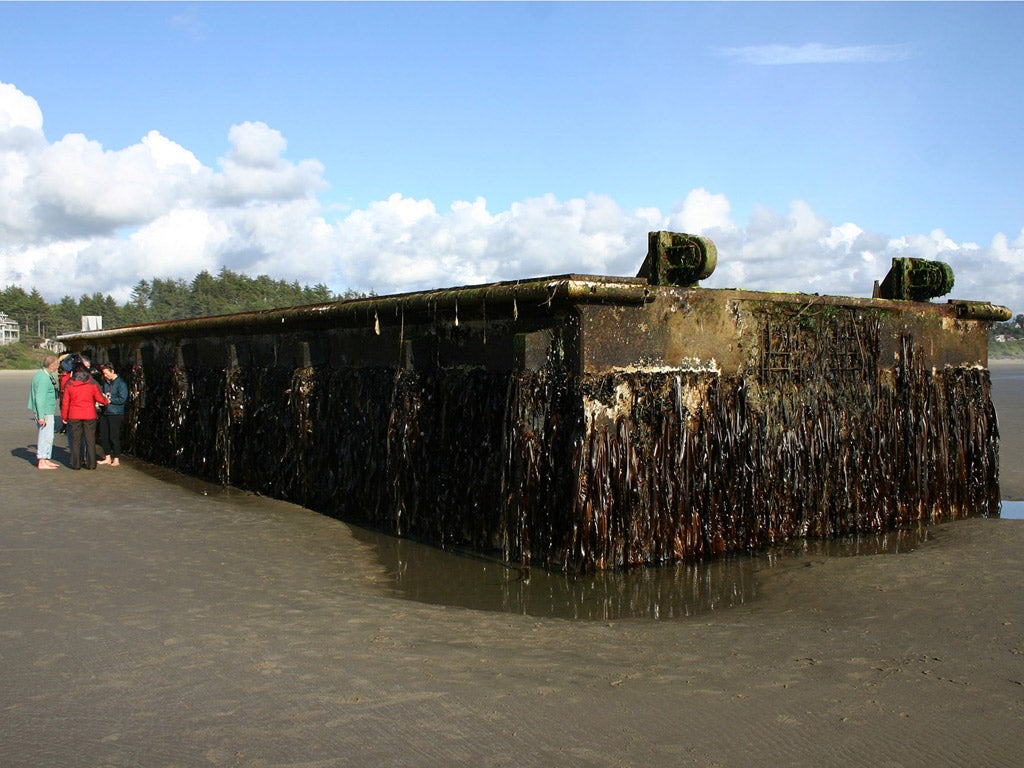Barnacle-encrusted reminder of Japan's tsunami docks in Oregon

For years, the fishermen of Misawa, a small town on the north-eastern corner of Japan's main island, Honshu, set sail from one of four outwardly unremarkable floating docks, built using concrete and steel and adorned, for largely protective purposes, with several dozen old car tyres.
Then, on 11 March last year, an earthquake measuring 9.0 on the Richter scale struck 43 miles out to sea. It was followed by a devastating, 40-metre tsunami which destroyed tens of thousands of buildings across Japan, killed around 13,000 people, and tore Misawa's docks loose.
They bobbed around in the Pacific for several months, floating east on ocean currents – until last week, when residents of central Oregon noticed one of the structures sitting a short distance off their coast. In the early hours of Tuesday morning, its journey ended when it washed up on Agate Beach, a mile north of Newport.
The 165-tonne "tsunami dock" has quickly become a minor tourist attraction, forcing officials to post signs warning onlookers against clambering on it to take souvenir photos. Tests for radiation have (thankfully) proven negative, but to the apparent concern of US marine biologists, several non-native species of starfish and algae appear to have survived its 5,000-mile journey.
In April, coastguards in Alaska used a cannon to sink the Ryou-Un Maru, a crewless and rusty fishing boat which had drifted within sight of Sitka and was in danger of impeding shipping lanes. It burnt and sank in 6,000 feet of water.
Few "tsunami debris" tales are more miraculous that that of a football belonging to 16-year-old Misaki Murasami. Given to him as a school leaving gift and covered in messages from former classmates, it was recently discovered by David and Yumi Baxter on a beach in Alaska. They telephoned Murasami with news of their discovery, and intend to fly to Japan to ensure its safe return.
Dock: Found on Agate Beach, Oregon
Distance travelled 7,280km
Beached yesterday, the 66ft pontoon from Misawa, made of concrete and steel but filled with styrofoam, is one of four such docks that broke loose during the tsunami.
Ghost ship: Found floating 170 nautical miles south-west of Sitka, Alaska
Distance travelled 5,350km
The Ryo-Un Maru was sunk by the US Coast Guard after it became concerned that the 200ft fishing vessel could threaten other shipping off the US west coast. A Canadian group tried to salvage the rusting hulk, which was in the process of being scrapped when the tsunami hit. When that failed the Coast Guard fired 25mm cannon shells until it burst into flames and sank in about 6,000ft of water.
Harley Davidson: Found on Graham Island, British Colombia
Distance travelled 6,485km
Found inside a shipping container along with camping equipment and golf clubs, it was identified as belonging to Ikuo Yokoyama, 29, who lost three members of his family during the disaster.
Football: Found on Middleton Island, Alaska
Distance travelled 5,390km
Misaki Murakami's treasured football was found by a couple walking along a beach. They were able to identify the schoolboy as the owner of the ball because it was inscribed with his name by former classmates when he changed schools in 2005.
Join our commenting forum
Join thought-provoking conversations, follow other Independent readers and see their replies
Comments
Bookmark popover
Removed from bookmarks